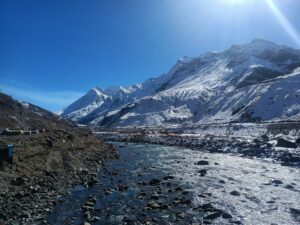In today’s fast-paced world, more and more travelers are seeking authentic, immersive experiences that connect them to nature and culture. This growing demand has made trekking & hiking tourism one of the most popular forms of adventure travel. Far beyond just a walk in the mountains, trekking offers unforgettable encounters with landscapes, people, and personal endurance. Whether you’re navigating alpine meadows, dense forests, or high-altitude passes, trekking tourism provides a unique way to explore the world at a slower, more meaningful pace.
What is Trekking & Hiking Tourism?
Trekking & hiking tourism involves traveling on foot through natural environments, often in remote or rugged terrains. While hiking typically refers to shorter walks on marked trails, trekking usually means longer, more challenging journeys that can span several days. This form of tourism is not only about reaching the destination but enjoying the journey, the scenery, and the cultural experiences along the way.
Benefits of Trekking & Hiking Tourism
1. Close Encounter with Nature
Trekking allows you to immerse yourself in pristine environments—mountains, forests, rivers, and valleys—that are often unreachable by road.
2. Physical and Mental Well-being
It boosts cardiovascular health, builds stamina, and improves mental clarity. The peaceful surroundings and physical activity work wonders for stress relief.
3. Cultural Exploration
Many treks pass through traditional villages and tribal regions, offering insight into local customs, lifestyles, and food.
4. Sustainable and Responsible Travel
Trekking has a low environmental footprint. When done responsibly, it promotes eco-tourism and supports rural economies.
Top Trekking Destinations in India
India’s diverse terrain offers countless trekking options—from the Himalayas in the north to the Western Ghats in the south.
1. Chadar Trek, Ladakh
One of the most unique treks in the world, it involves walking on the frozen Zanskar River during the winter months. It’s a test of endurance and an extraordinary experience.
2. Valley of Flowers, Uttarakhand
This UNESCO World Heritage Site is a floral paradise surrounded by snow-capped peaks. The trek is relatively easy and ideal for nature lovers.
3. Roopkund Trek, Uttarakhand
Famous for its mysterious skeletal lake, this high-altitude trek offers stunning views of Mt. Trishul and Nanda Ghunti.
4. Hampta Pass Trek, Himachal Pradesh
Ideal for beginners, this trek connects the lush Kullu Valley to the arid landscapes of Spiti, showcasing dramatic scenery changes.
5. Kumara Parvatha Trek, Karnataka
A popular trek in South India, it involves challenging climbs, dense forests, and spectacular views, attracting adventure seekers from across the country.
International Trekking Hotspots
If you’re ready to explore the globe on foot, consider these legendary international treks:
- Inca Trail, Peru – A historic trek through ancient Incan ruins leading to Machu Picchu.
- Everest Base Camp Trek, Nepal – One of the world’s most iconic high-altitude treks.
- Camino de Santiago, Spain – A spiritual pilgrimage through historic towns and picturesque countryside.
- Torres del Paine, Chile – A trek through Patagonia’s dramatic mountains, lakes, and glaciers.
What’s Included in Trekking & Hiking Tourism Packages?
Well-organized trekking packages typically include:
- Accommodation in tents, lodges, or homestays
- Guided treks with experienced local professionals
- Meals during the trek
- Trekking permits and entry fees (for protected areas)
- Porter services and safety equipment in difficult terrain
- Transfers from nearest airport or railway stations to the trailhead
Some packages also include acclimatization days, especially for high-altitude treks.
Tips for a Safe and Enjoyable Trekking Experience
- Know Your Fitness Level
Choose a trek that matches your physical ability and experience. Don’t underestimate the challenge. - Acclimatize in High-Altitude Areas
For treks above 2,500 meters, take time to adjust to prevent altitude sickness. - Pack Smart
Carry lightweight, moisture-wicking clothes, sturdy trekking shoes, a water bottle, torch, first-aid kit, and energy snacks. - Travel with a Guide or Group
Especially in unfamiliar or difficult regions, traveling with an experienced guide ensures safety and better navigation. - Respect Nature and Local Culture
Avoid littering, stick to marked trails, and always be respectful to locals and wildlife.
Best Seasons for Trekking
- Summer (April to June): Best for Himalayan treks like Roopkund, Kedarkantha, and Hampta Pass.
- Monsoon (July to September): Ideal for trekking in Ladakh and the Western Ghats.
- Autumn (September to November): Clear skies and pleasant weather make it ideal for trekking across India and Nepal.
- Winter (December to February): Best for snow treks like Chadar and Dayara Bugyal (only for experienced trekkers).
Conclusion
Trekking & hiking tourism is more than a physical activity—it’s a spiritual and transformative journey. Each trail has its own story, every peak offers a new perspective, and each step brings you closer to nature and yourself. Whether you’re looking to conquer a Himalayan pass, wander through flower-filled meadows, or discover new cultures, trekking holidays offer the perfect blend of adventure, wellness, and discovery. So lace up your boots, take a deep breath, and set off on a journey that will stay with you for a lifetime.
In today’s fast-paced world, more and more travelers are seeking authentic, immersive experiences that connect them to nature and culture. This growing demand has made trekking & hiking tourism one of the most popular forms of adventure travel. Far beyond just a walk in the mountains, trekking offers unforgettable encounters with landscapes, people, and personal endurance. Whether you’re navigating alpine meadows, dense forests, or high-altitude passes, trekking tourism provides a unique way to explore the world at a slower, more meaningful pace.


